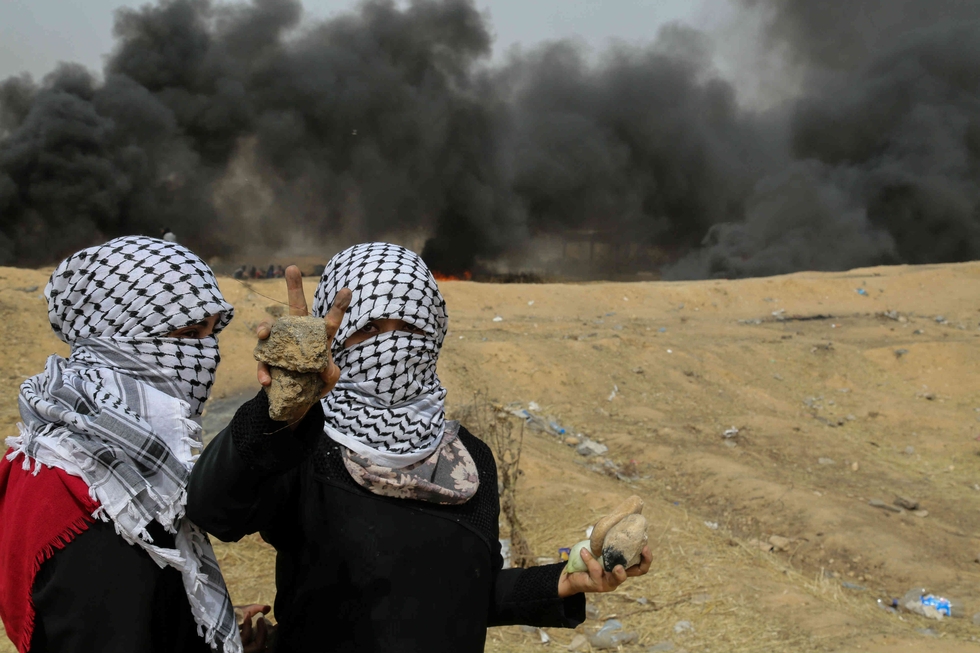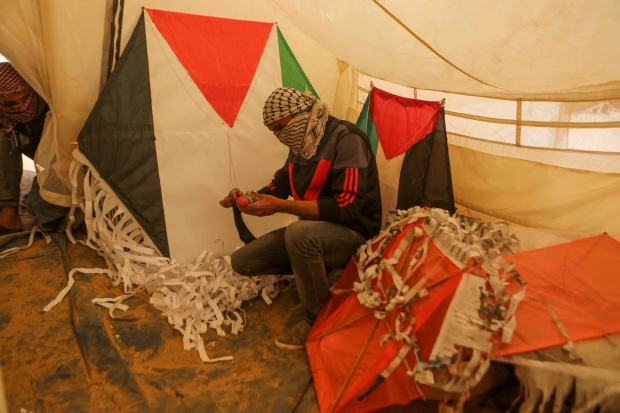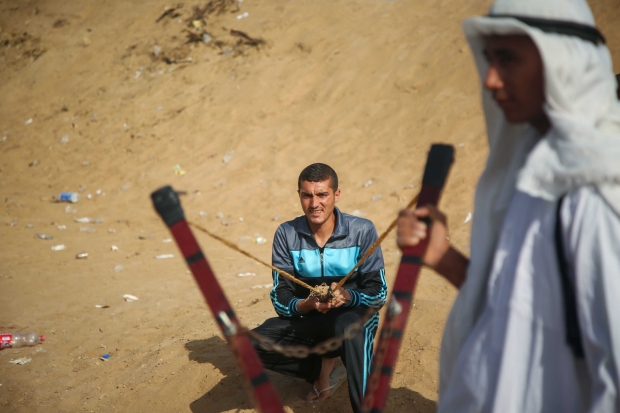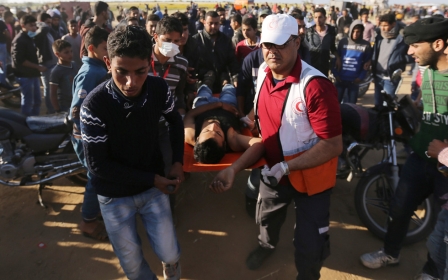Four killed as Gaza 'Great March of Return' protests enter fourth week

Four Palestinians, including a teenager, were killed in the Gaza Strip on Friday as the besieged territory entered the fourth week of demonstrations as part of the "Great March of Return”.
While Friday protests typically gain traction following noon prayers, the Gaza ministry of health reported in the morning that a Palestinian had been grievously wounded after being shot in the head east of Jabalia, in the northern Gaza Strip.
In the afternoon, the ministry confirmed that 25-year-old Ahmad Nabil Abu Aql had died from his wounds.
A few hours later, the ministry of health reported the death of Ahmad Rashad al-Athamna, 24, shot dead by Israeli forces in the north of the strip.
In the evening, the ministry announced that 15-year-old Mohammed Ibrahim Ayoub, was killed east of Jabalia, while Saad Abd al-Majid Abu Taha, 29, succumbed to his wounds after being shot in the neck east of Khan Younis.
The ministry stated that at least 645 Palestinians had been injured during Friday's demonstration as of 6 pm local time, including 24 minors and 12 women.
An MEE correspondent in Gaza also reported that a paramedic had been critically injured after being shot by Israeli forces east of the city of Khan Younis in the southern Gaza Strip, while journalist Mohammed al-Sawalhi was shot in the hand with an expanding dumdum bullet, and Palestine TV correspondent Sally al-Sakani suffered from severe tear gas inhalation.
According to the correspondent, in addition to shooting live bullets, Israeli forces were also heavily firing tear gas into Gaza, as surveillance planes flew just above demonstrators in some areas, including near Jabalia.
Several media vehicles were targeted by Israeli forces, as MEE's correspondent reported seeing the Israeli army fire tear gas canisters directly at vehicles used for live broadcasting east of Gaza City.
Meanwhile, Hamas-affiliated Shehab news agency shared a photograph of a press vehicle with a window seemingly broken by a large projectile, without specifying where the incident took place.
East of al-Bureij refugee camp in the central Gaza Strip, at least five Palestinians, including a minor, were injured when Israeli forces shot at a group of demonstrators trying to remove barbed wire installed by the Israeli army on the Gaza side of the fence.
Demonstrators have been gathering several hundred metres from the fence separating Israel from Gaza, where almost 1.3 million of the small territory’s two million inhabitants are refugees, to demand the right to return to their pre-1948 homes.
Protest organisers have officially labelled Friday's protest in support of "martyrs and prisoners", in light of Palestinian Prisoner's Day earlier this week, but on social media some Palestinians dubbed it the "Friday of Kites".
“The whole international community is focusing on what is happening in Gaza, so it is important to shed light on the Palestinian detainees’ cause, and also to highlight that this peaceful protest was faced with excessive munition, causing 34 martyrs,” Salah Abd al-Ati, the head of the Great Return March’s legal committee, told Middle East Eye. “While Israel continues its brutal policy against Palestinian prisoners neglecting their rights, we reject its policies of solitary confinement and administrative detention.”
While in the past few weeks demonstrators have burned tyres and Israeli flags, on Friday, more and more protesters were flying kites painted in the colours of the Palestinian flag.
Jamal Nasser, 24, has been building kites for the past few days with friends, writing messages such as “We will never leave our land” and “You kill children and unarmed civilians” for Israelis to see from the sky.
“Kites are symbol of peace in all the world,” the young man told MEE. “We fly kites to ensure our right to freedom.”
Some protesters were attaching Molotov cocktails to the kites, although AFP reported that such kites did not cause much damage if they reached past the fence.
"They (the soldiers) are firing explosive bullets and tear gas, we are flying kites to burn the farmland," a 17-year-old who did not want to be named told AFP.
"We use the kites to send a message that we are capable of bothering the occupation," 16-year-old Abdullah told the news agency.
The planned six-week protest, which began on 30 March on Palestinian Land Day, is set to end on 15 May - the 70th anniversary of the Palestinian Nakba (Catastrophe), in which more than 750,000 Palestinians were forcibly displaced by Israeli forces during the 1948 Arab-Israeli war.
According to the ministry of health, 37 Palestinians have been killed and more than 4,300 have been wounded by Israeli forces since the "Great March of Return" began on 30 March.
You are participating in violent disturbances. Hamas is taking advantage of you to carry out terrorist attacks. The IDF is prepared for any scenario. Stay away
- Israeli army leaflet
No Israeli casualties have been reported.
The Israeli army has rejected repeated pleas by the international community to use restraint and to conduct an independent inquiry into the deaths, maintaining the necessity of its open-fire policy.
According to Israeli newspaper Haaretz, the Israeli army has dropped leaflets in Gaza warning people to steer clear of the demonstrations.
"You are participating in violent disturbances. Hamas is taking advantage of you to carry out terrorist attacks. The IDF is prepared for any scenario. Stay away from the fence and do not attempt to damage it," the leaflets reportedly read.
Meanwhile, the army's Arabic spokesman, Avichay Adraee, has argued that any woman going to protest in Gaza "lacks honour" and "acts wildly against her feminine nature" - drawing sharp rebukes from female demonstrators themselves.
Gaza, which has been under blockade for almost 11 years, has found itself further strained due to the high number of injuries.
At least 17 Palestinians have had to have limbs amputated after not having access to sufficient care, the health ministry said earlier this week, calling on foreign NGOs and nations to send more medical supplies, and for Israel to allow more patients to exit the small coastal territory to receive treatment in the occupied West Bank.
Israeli army radio reported on Thursday that Palestinian journalist Ahmad Abu Hussein, who was shot in the abdomen on 13 April and taken to the West Bank for treatment, had been transferred to an Israeli hospital due to the severity of his condition.
Translation: Palestinian journalist Ahmad Abu Hussein was evacuated from Ramallah to the Tel HaShomer hospital in the wake of a rapid deterioration in his condition. Abu Hussein... is the first casualty in the wave of riots to receive treatment in Israel.
International medical organisation Doctors Without Borders (MSF) said in a statement on Thursday that it had treated more wounded people in Gaza in the past three weeks than it had throughout all of 2014 - the year of the last Gaza war.
"MSF medical staff report receiving patients with devastating injuries of an unusual severity, which are extremely complex to treat," the statement read. "The injuries sustained by patients will leave most with serious, long-term physical disabilities."
Middle East Eye propose une couverture et une analyse indépendantes et incomparables du Moyen-Orient, de l’Afrique du Nord et d’autres régions du monde. Pour en savoir plus sur la reprise de ce contenu et les frais qui s’appliquent, veuillez remplir ce formulaire [en anglais]. Pour en savoir plus sur MEE, cliquez ici [en anglais].







